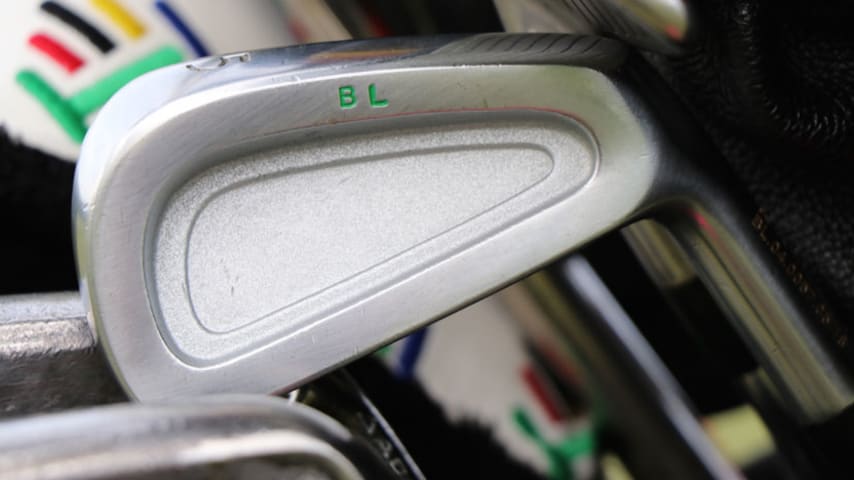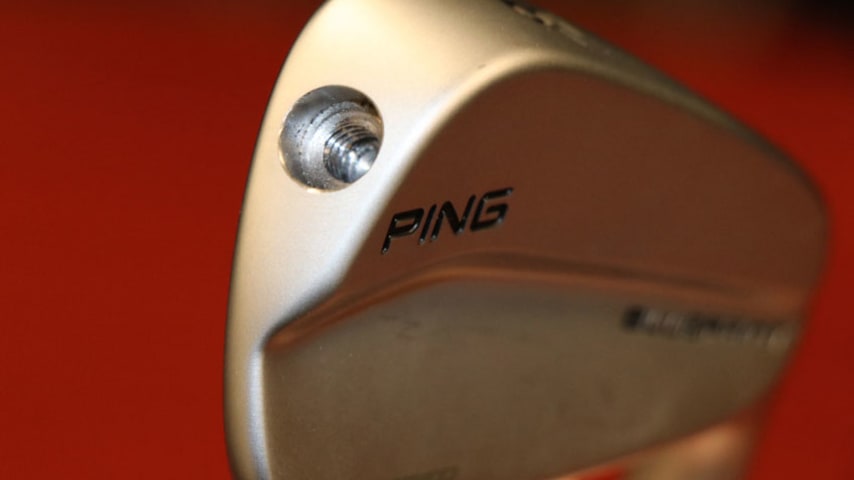Mike Taylor goes in-depth on Bernhard Langer’s custom Artisan irons
7 Min Read

At last week’s PNC Father/Son Challenge, I watched 61-year-old Bernhard Langer methodically hit golf balls on the driving range. Using a short-iron, he was landing shot after shot in almost the exact same spot. It was mesmerizing.
Then I was taken aback when I looked at his golf bag. There was a TaylorMade RSi Forged pitching wedge, a blank blade 9-iron, Adams Idea Pro Black mid-irons, and a blank cavity-back 5-iron stamped only with his initials on the back cavity.
“What is going on here?” I thought to myself.
It’s common for golfers to use a mixed set of irons -- preferring the precision of blades for short-irons and the forgiveness of cavity-backs in their long-irons -- but irons from completely different sets? That’s not normal. And who makes those beautiful blank irons?
After taking a closer look, I noticed a serial number stamped on the hosel of the 5-iron … a serial number that I know to be the signature stamping of Mike Taylor Artisan Golf in Fort Worth, Texas.
Taylor is a legendary master craftsman known throughout the golf equipment world for his work with Nike Golf. He didn’t leave his post when Nike exited the golf-club business, however. He started Artisan Golf – a custom putter, wedge and iron company – and now crafts clubs in the same Fort Worth workshop that his old employer once occupied.
Artisan Golf earned attention in 2018 for making the wedges that Patrick Reed used to win the Masters. Abraham Ancer used a set of Artisan wedges en route to a win at the Australian Open. But knowing Bernhard Langer, and how different his golf clubs are, I knew there was an interesting backstory to how Artisan irons ended up in his bag.
So, I reached out to Mike Taylor to get the story on Bernhard’s Artisan-made blade 9-iron and cavity-back 5-iron. Enjoy Taylor’s tales below.
On Langer’s mixed set of irons, from three different manufacturers …
“Hey, how about that bag. That is what you call the real deal. That bag is an incredible testament to golf equipment, and the effort that it takes. You test stuff, you find out what it takes for you, and that’s it.
“Me and the boys, we did the ’99 Apex irons back in the day, and he sent a bunch of clubs here once so we could measure them all out. And his long-irons, at that time, were ’99 Apex raws that had enough lead tape on those things they could have gotten clearance on a nuclear reactor. But you know what, I love the way he looks at his stuff. An 8-iron is an 8-iron. (He doesn’t have to play a 7-iron) just because it’s married to the 8-iron. He’s looking for 14 tools that he’s got confidence in, and that’s all it is.”
On how Langer’s irons came about …
“He got our number or I got his. He probably tried to call me and missed me because I can’t hear nothin’ in this shop, so I called him back and we started talking about some things. It started the right way. I got an opportunity to blueprint some of his golf clubs. What I needed to do at that point was go digging through all of these old forgings. I needed to find out, upfront, whether it looked like something we could do, because it’s pretty old-school type stuff. I had to go look at my steels to say, hey, I’ve got some forgings here that we can make some golf clubs out of that are worth testing.
“To give you a little bit of a backstory on how that happened, one of my buddies was a fitter here at The Oven for a long time. He works for Titleist now, but Scott worked with Bernhard a lot when he worked for Adams back in the day. The story was that (Bernhard) had been looking for new irons for years, but he’s very sensitive. You know, when you put his clubs down, if you held them, you’d see a lot of offset in those golf clubs. And that’s one of the things that his eye is very keen to, is the offset that he likes.
“We made some golf clubs at first, they were just some clubs that I ground on. We had some finished heads and we built them up, sent them to him, he tested them. And based upon those tests, he decided that initially he wanted us to make him a blade set. We made the blade set first. Then, he tested those. Then, when they were playing at the event in Houston this year, Scott and myself did some additional testing with him. We took some of the cavity-back stuff with us. And that test results in ‘Ok, I want you to make me a cavity back set.’ So, we made a blade set and a cavity-back set.
“A few times before I had worked with guys that I felt kind of individualized the tools, but this man, seriously, a 5-iron is a 5-iron.
“He’s being doing stuff like that for a good while. Obviously, good gosh, he’s had those Apex irons forever. I haven’t really looked lately to see what’s all (in his bag) but, I’m proud that he’s got a couple of our irons in there. Most people would go, ‘Well Mike, that’s not that good if you made 16 clubs and you get two.’ But, hey, to make the cut with a couple of them, that’s gettin’ somewhere, right? (laughs)”
On building irons with more offset …
“I just happened to have amongst a pile of old forgings here some irons that, because of the finish that they were, were very weak-lofted forgings. When you start with a weak forging, and you bend it to a strong spec, you add offset. Those irons were heading in the right direction from when we bent them.
“It was such an ironic set to do that work for him. It was a real honor, you know. But it was like, I spent my whole career knocking offset out of golf clubs for these guys and trying to make them look less offset, and (Bernhard) wants a lot of offset. We had blueprinted some of his (old clubs) and figured out where the specs were. Of course, he’s still playing an Apex shaft, which was developed by the Ben Hogan Company a zillion years ago. And we happened to have access to some of those. So between the needs to do the builds and the heads, we did some work for the man.”
On what makes Langer’s iron shafts special …
“That was a well-received golf shaft for many, many, many years. I don’t remember how many years he said he played that shaft, but way longer than I’ve been in this business, and I’ve been doing this 31 years. It is a shaft that he’s very comfortable with. He’s played it for a long time, and if it’s not broke, then don’t go trying to fix it.
“So we located somebody or knew somebody that actually had some new blanks, not pull-outs or anything like that, of some Apex shafts. It was a great shaft. The Ben Hogan Company irons were very, very well-received back in the day. The shafts are one of the most important components in a great set of irons. So that’s just one variable that didn’t have to be looked at, his shaft or his grip or his specs, we just had to get some fresh heads with some fresh grooves that he can go play some golf with.
“I just got a kick out of the whole deal. Between being able to get the shafts that we needed to build those sets the proper way, and to be able to have anything in that man’s bag, I’m pretty tickled with that.”
On Bernhard Langer …
“Is he not one of the nicest guys? Man, he’s just a great guy. He’s awesome to work with. He’s inquisitive, asks a few questions, kinda quiet, but to watch him work, man. He knows a lot about what he wants to see and he knows what he wants his ball flight to look like. He’s already made that decision on what he’s looking for, it’s just gotta fulfill all the needs.
“He’s a player. He can hit it still. He won at Houston too didn’t he? I think he won that week we were down there.”
Yes, he did. Langer won the 2018 Insperity Invitational at The Woodlands Country Club near Houston. He also won the 2018 SAS Championship in October by six shots. Langer now has 38 wins on PGA TOUR Champions victories, seven short of Hale Irwin’s record. He’s proven to be a master of his craft, wielding a unique set of tools.




